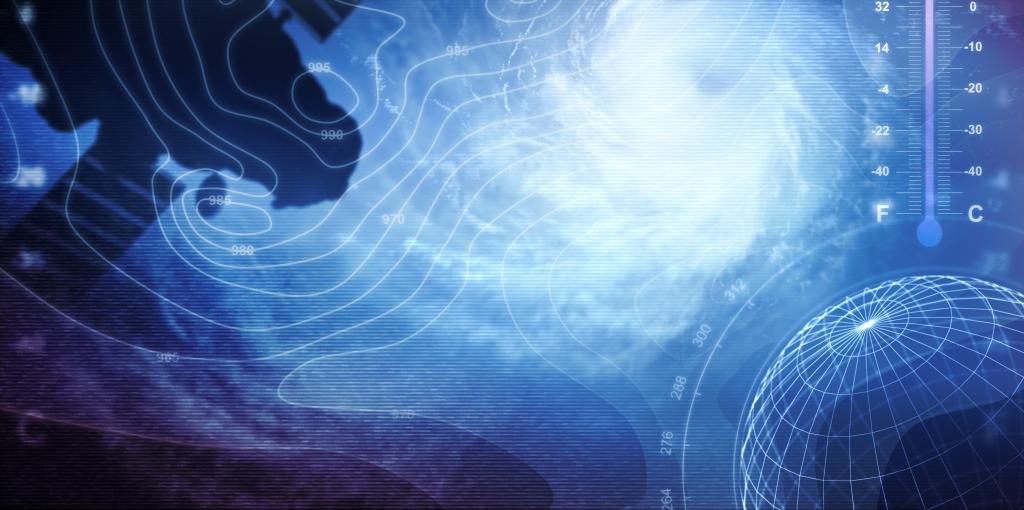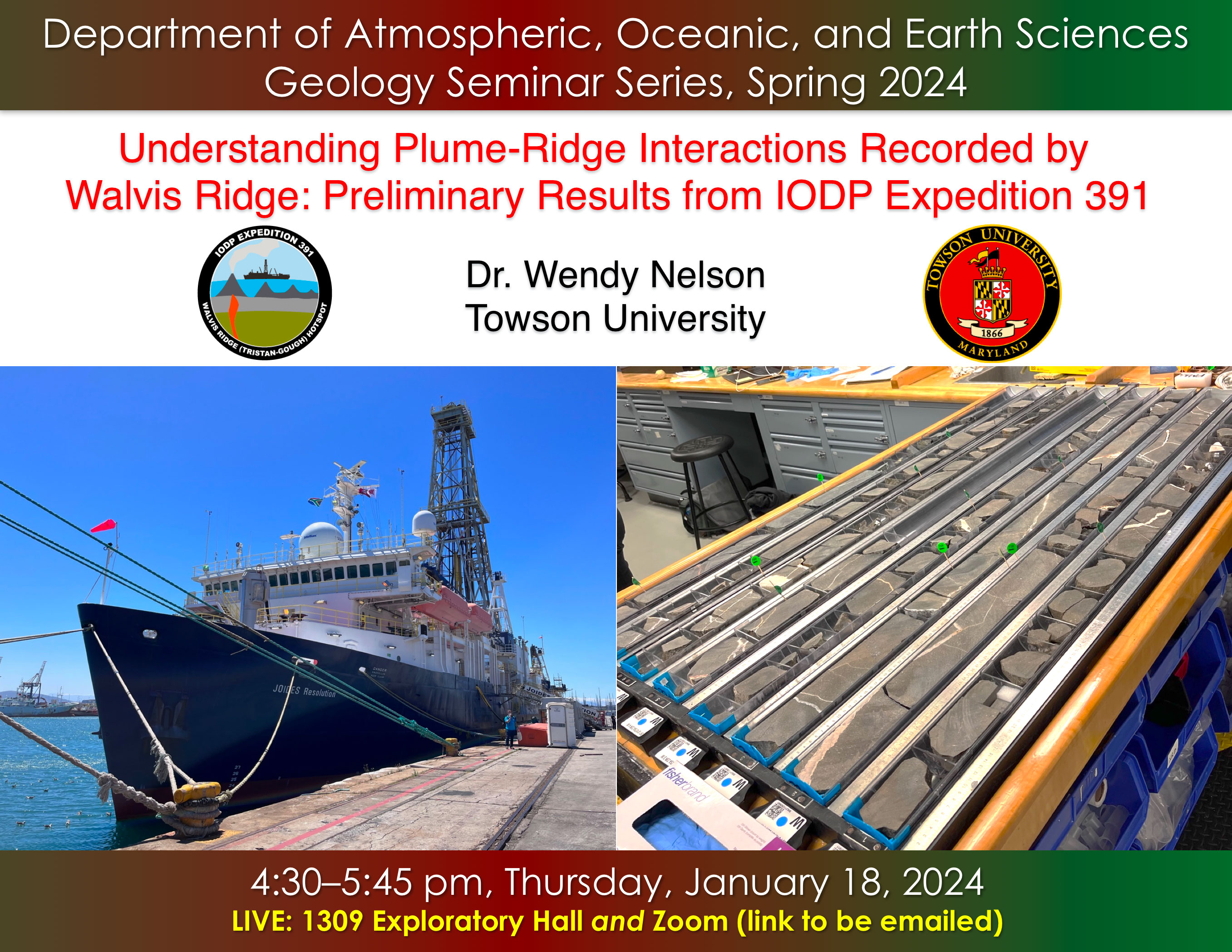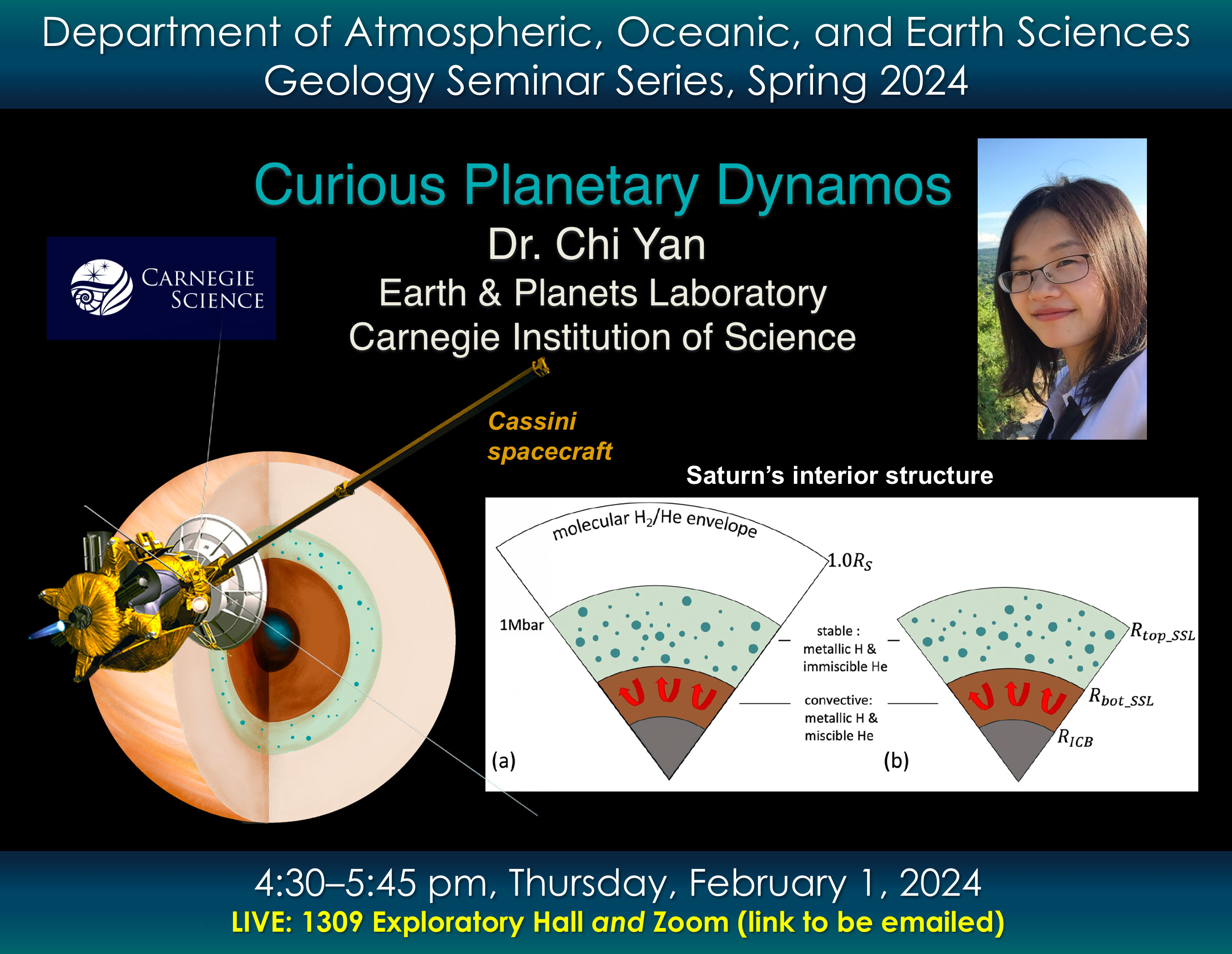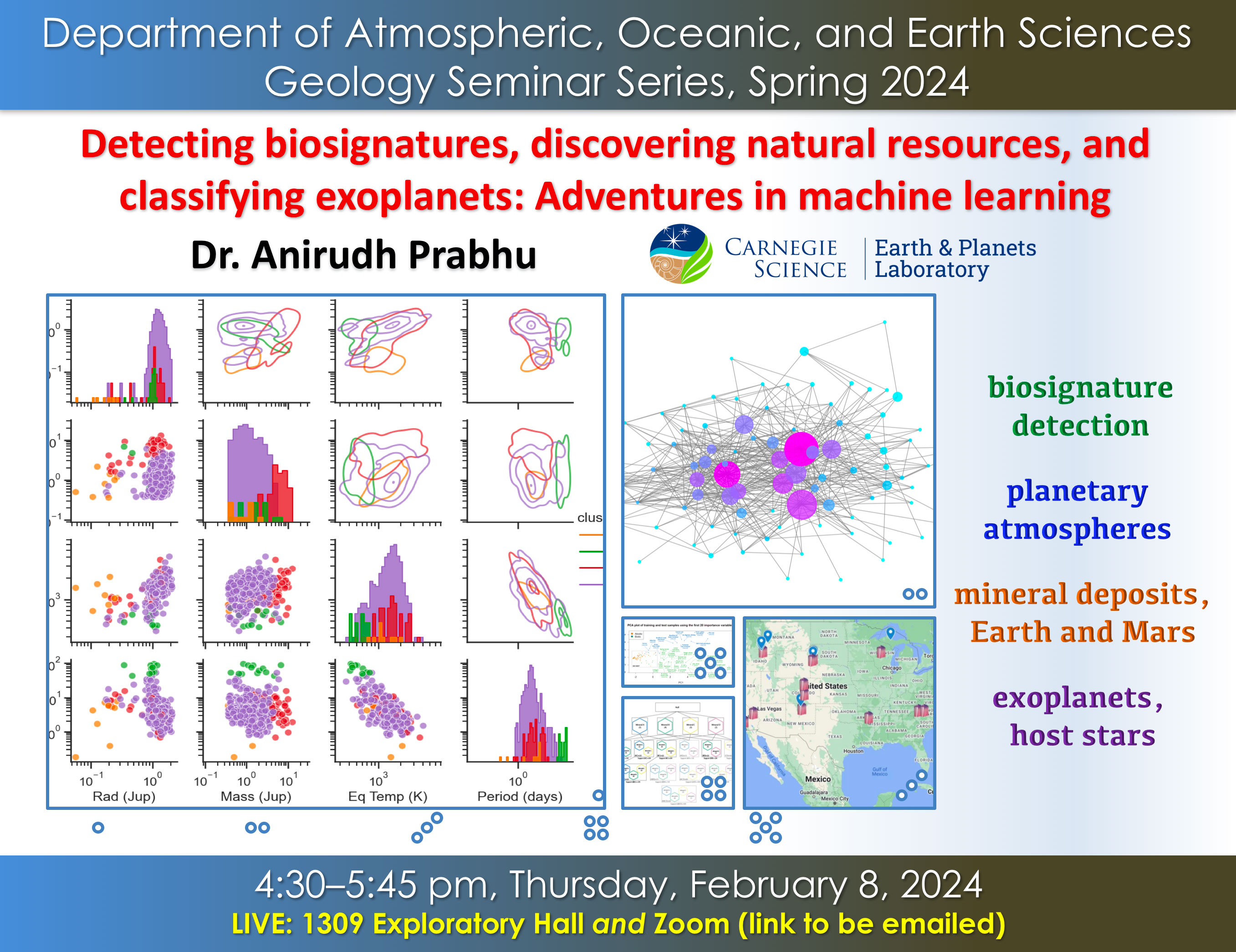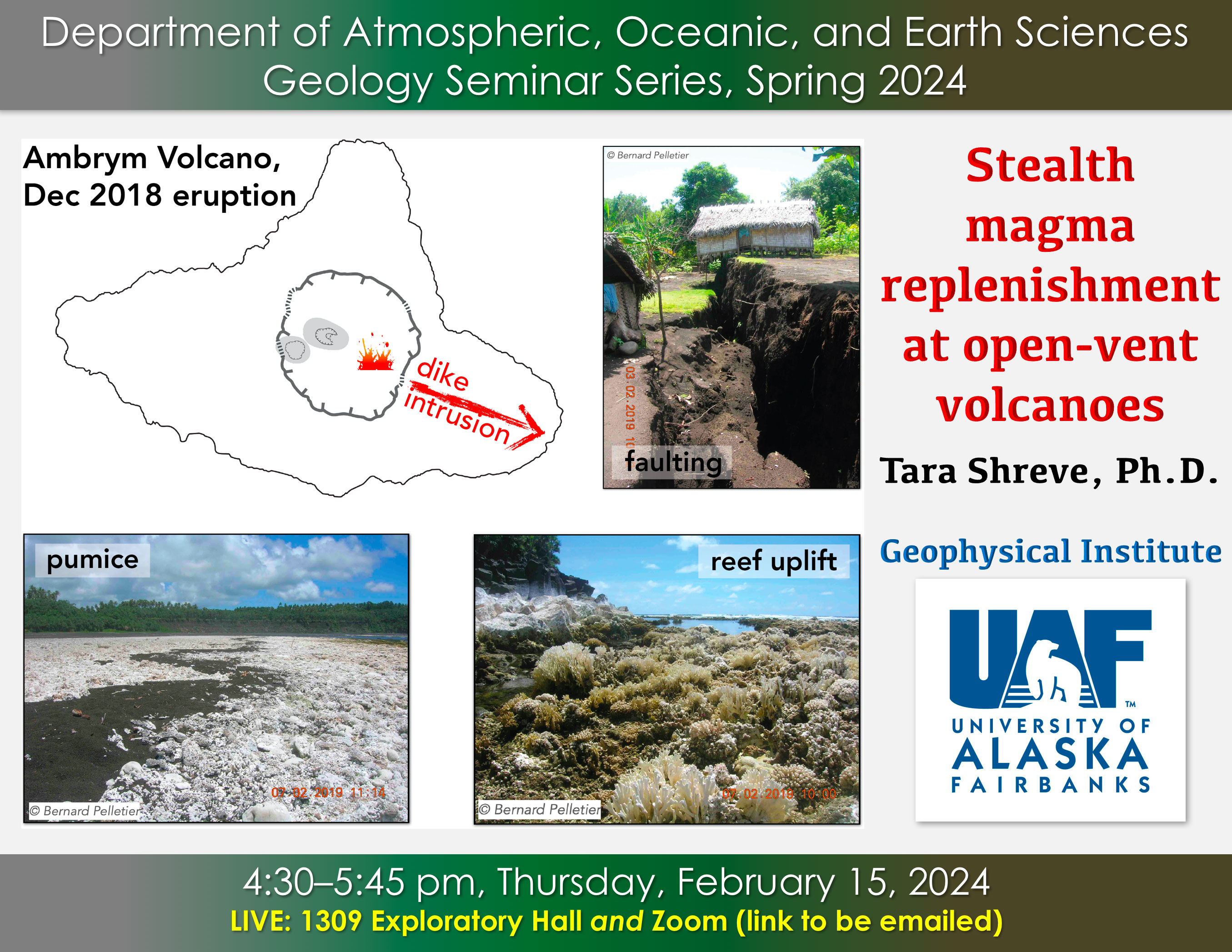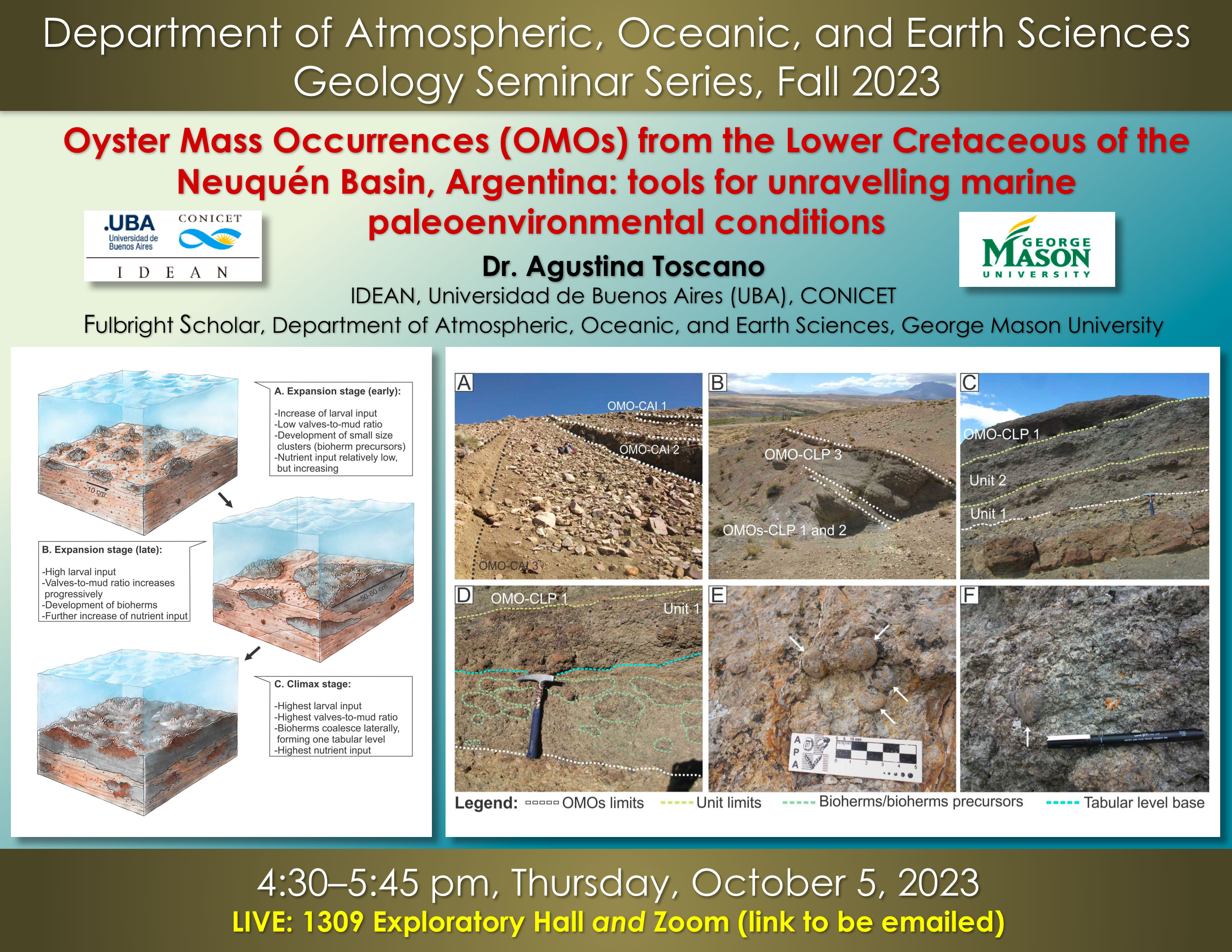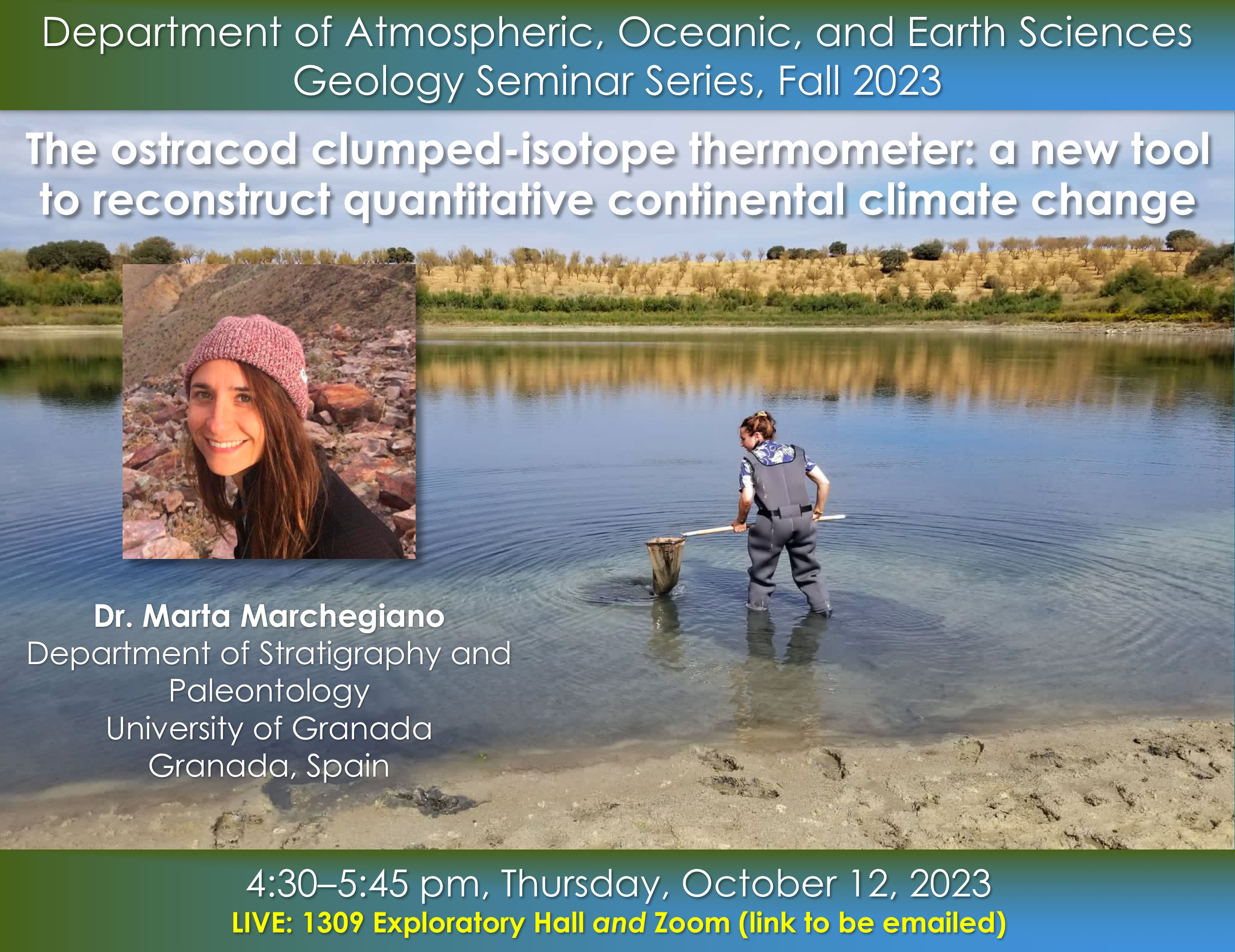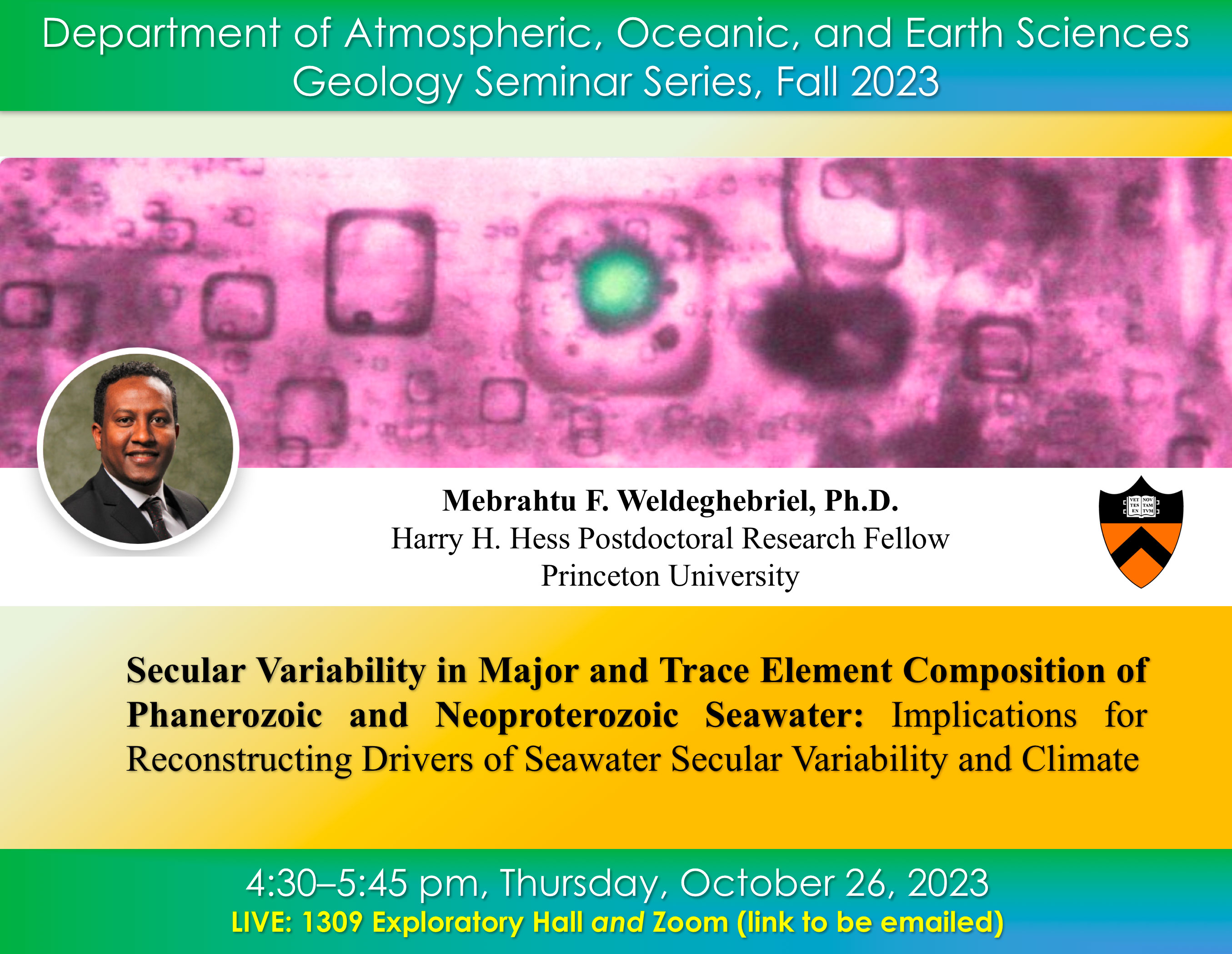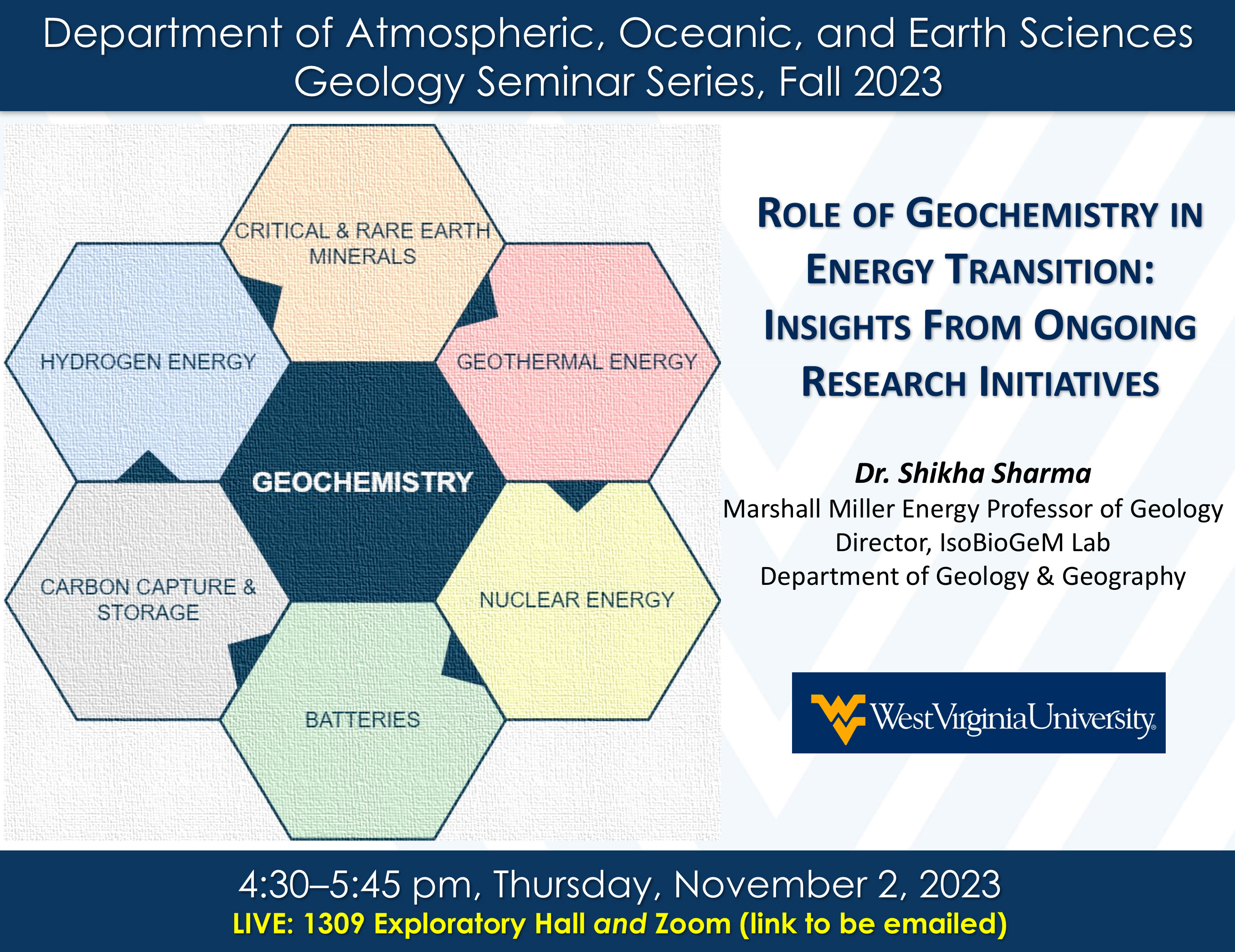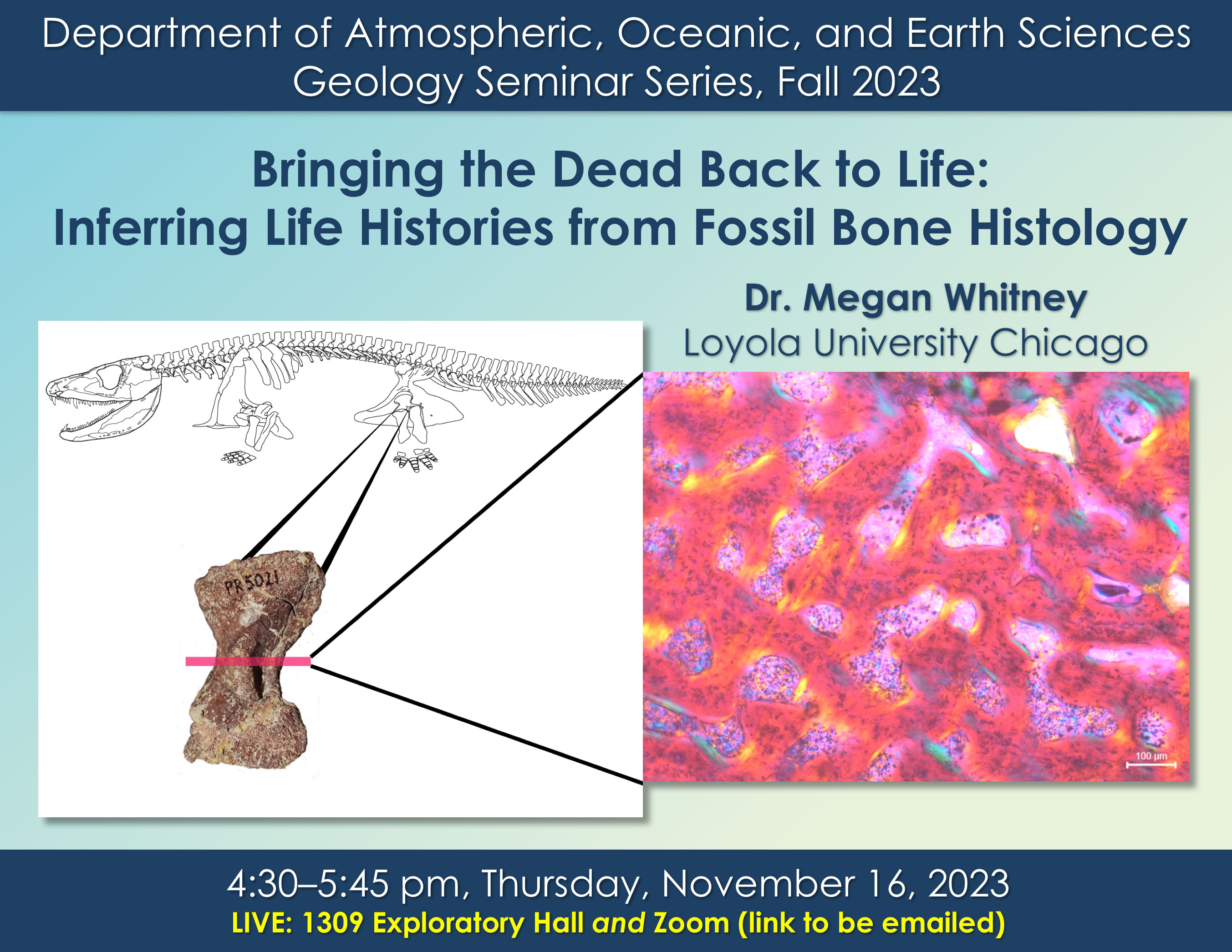2023-2024 Seminars
Admission CTAs
Main navigation
Section Navigation: AOES Seminars
Summer 2024 AOES Seminars
24 Jul (CLIM) Buchmann, PhD Defense, Identifying the Most Predictable Subseasonal Modes
Paul Buchmann, George Mason University
Climate Dynamics PhD Defense
Identifying the Most Predictable Subseasonal Modes
Wed, 24 Jul, 11:00am, Horizon Hall Room 3010 and via Zoom(for link, email tdelsole@gmu.edu)
Advisor: Tim DelSole
This talk will present new sources of subseasonal predictability for temperature over the United States. Historically, distinct components of large-scale climate variability were identified using a variety of methods, and their impact on predictability was later derived using knowledge of that variation. By focusing on identifying components of variability first, have we overlooked some sources of predictability? To identify predictability in temperature without first knowing what causes it, we calculate the lagged correlations in temperature fields using Canonical Correlation Analysis (CCA). Then, when we know the predictable temperature signal, we can investigate the source of the predictability using the same widely used methods in predictability studies. Several modes of predictability are identified at weeks 1-2 and weeks 3-4 for all seasons, some of which are found to be independent of known sources of predictability. This talk will describe two new predictable summer modes in depth as well as the source of this predictability.
25 Jun (CLIM) Doyle, MS Defense, MJO-ENSO Relationship
Loren Doyle, George Mason University
Climate Science MS Thesis Defense
Evaluation of the MJO-ENSO Relationships Using UFS Reforecasts and the Impact of Skin Layer Variability on this Relationship
Tue, 25 Jun, 1:00, Research Hall 281 and via Zoom (for link, email cstan@gmu.edu)
This study investigates the performance of the Unified Forecast System (UFS) global coupled model to forecast the relationship between the Madden-Julian Oscillation (MJO) and El Niño-Southern Oscillation (ENSO) through the calculation of the MaKE and MaKI indices, developed in the ocean-atmosphere energetic framework. The MaKE index describes the covariability of MJO, Kelvin wave activity, and ENSO. The MaKI index characterizes the influence of MJO and Kelvin wave activity on ENSO through the wind power. The indices are calculated as a multivariate EOF analysis of the MJO components of meridional and zonal wind stress and the Kelvin components of meridional and zonal ocean surface currents combined as the MJO wind power, and sea surface temperature daily anomalies. UFS reforecasts of two prototypes for April 2011-March 2018 are used. Each reforecast has 35-day forecast leads, which poses challenges for isolating the intraseasonal component of the wind stress. To address this limitation, a novel filtering approach using a convolutional neural network (CNN) artificial intelligence model was applied to capture the intraseasonal variability of the wind stress anomalies. Prototypes 6 and 8 are selected due to the exclusion/inclusion of the near-surface sea temperature model (NSSTM).
The results show that the UFS prototypes predict the El Niño events in 2014-2015 and 2015-2016, and the MJO-ENSO interaction for the events as seen in the verification data. The deterministic forecast skill of the model predictions of MJO, ENSO, and the MJO-ENSO relationship compared to the observations are analyzed using pattern correlation and RMSE. The addition of NSSTM results in improved MaKE indices, but worsened MaKI indices for both El Nino events.
25 Jul (CLIM) Nedza, PhD Defense, Separating Forced and Internal Variability
Douglas Nedza, George Mason University
Climate Dynamics PhD Defense
Thu, 25 Jul, 10:00am, Johnson Center Meeting Room A and via Zoom(for link, email tdelsole@gmu.edu)
Advisor: Tim DelSole
Separating Forced and Internal Variability in North Atlantic Sea Surface Temperature
Quantifying the relative contributions of external forcing and internal variability to North Atlantic Sea Surface Temperature (NASST) has important implications for attributing and predicting climate changes around the North Atlantic basin. Many previous methods have approached this problem by estimating the externally forced signal directly, making assumptions about forced variability for which there is no consensus. In this work, the separation of variability is approached in a fundamentally different way that does not specify the forced response's temporal evolution. We propose a dynamical adjustment method in which the internal, spatially uniform component of NASST is predicted based on patterns of NASST that are orthogonal to the spatially uniform pattern. This dynamical adjustment method is trained and validated in preindustrial simulations, where only internal variability is present. In preindustrial simulations, the dynamical adjustment demonstrates skill in reconstructing the NASST basin mean variability. Applying the preindustrial-trained dynamical adjustment to historical simulations demonstrates skill in a majority of climate models, although the skill is reduced relative to preindustrial simulations because external variability partly contaminates the predictors. The skill of dynamical adjustment is compared to several other methods which directly estimate the externally forced signal. We find that dynamical adjustment performs similarly to these comparative methods, despite the fundamentally different prediction method. However, methods based on different principles yield considerably different estimates of external and internal variability.
In efforts to contend with the presence of external variability in predictor time series in historically forced simulations, several modifications to the dynamical adjustment methodology are investigated. Most directly, low-frequency filters are applied to the predictor time series to estimate and remove any external variability. We find that the filters applied in this study do not skillfully identify the external variability, and the application of dynamical adjustment using these filtered predictors does not demonstrate a consistent improvement. Modifying the dynamical adjustment by training in historical simulations or including the NASST basin mean as a predictor is also explored. While training using historical simulations does not produce a more skillful dynamical adjustment on its own, we find some variations of dynamical adjustment that include the NASST basin mean as a predictor can produce skill equal to or greater than the original, preindustrial-trained dynamical adjustment.
Several variations of dynamical adjustment are applied to observational data from ERSSTv5. These estimates of internal variability are fairly consistent amongst variations, but are distinguished in both amplitude and phase with some residual estimates produced by the comparative methods that directly estimate external variability. The range of estimated external and internal variability in ERSSTv5 reinforce the sensitivity to assumptions that underly different methods.
Graduate Symposium
2024 Earth System Observations and Modeling Graduate Symposium, March 22nd. Accepting Abstracts.

Spring 2024 AOES Seminars
17 Jan (CLIM) Kinney, Climate Change, and Health
Joint Seminar, AOES & Civil, Environmental, & Infrastructure Engineering (CEIE)
Pat Kinney, Boston U
Climate Change, Air Pollution, and Health
Wed, 17 Jan, 1:30 Johnson Center Mtg Room A and via Zoom (for link, email bklinger@gmu.edu)
Host: Lucas Henneman (GMU CEIE)
This presentation will trace Pat Kinney’s research into how climate change can adversely affect air pollution and health, and how actions to address climate change can yield health benefits from improved air quality as well as through other pathways
18 Jan (GEOL) Wendy Nelson, Igneous Petrology
Thurs., 4:30-5:45 pm; Live and Virtual;
1309 Exploratory Hall; Zoom link emailed weekly to subscribers. Also GEOL 392/792.
To be added to the subscribers list, contact Linda Hinnov: lhinnov@gmu.edu.
24 Jan (CLIM) Choi, Summer Temperature Bias
Nakbin Choi, AOES
Large-Scale Surface Air Temperature Bias in Summer over the CONUS in the UFS Prototype 8
Wed, 24 Jan, 1:30, Innovation 209 and via Zoom (for link, email bklinger@gmu.edu)
This study examined the sub-seasonal variability of surface air temperature bias over the Contiguous United States (CONUS) in the UFS P8. Using empirical orthogonal function (EOF) analysis, an east-west dipole surface air temperature bias pattern is separated in the summer. This bias pattern significantly correlates with the Rossby waves forced from the tropical Central Pacific. First, the bias in convective activity over the central Tropical Pacific can enhance the bias pattern. Second, the Rossby waves are not well reproduced in the UFS P8, which could be related to the biases in the subtropical jet over the North Pacific.
25 Jan (GEOL) TBA
Thurs., 4:30-5:45 pm; Live and Virtual; 1
309 Exploratory Hall; Zoom link emailed weekly to subscribers. Also GEOL 392/792.
To be added to the subscribers list, contact Linda Hinnov: lhinnov@gmu.edu.
01 Feb (GEOL) Chi Yan, Planetary Physics
Thurs., 4:30-5:45 pm; Live and Virtual; 1309 Exploratory Hall;
Zoom link emailed weekly to subscribers. Also GEOL 392/792.
To be added to the subscribers list, contact Linda Hinnov: lhinnov@gmu.edu.
7 Feb (CLIM) Vecellio, Climate & Human Health
Dan Vecellio, AOES
The effects of weather and climate on human health: a multi-scalar, multi-sectoral approach
Wed, 7 Feb, 1:30, Innovation 209 and via Zoom (for link, email bklinger@gmu.edu)
08 Feb (GEOL) Anirudh Prabhu, Machine Learning
Thurs., 4:30-5:45 pm; Live and Virtual; 1309 Exploratory Hall;
Zoom link emailed weekly to subscribers. Also GEOL 392/792.
To be added to the subscribers list, contact Linda Hinnov: lhinnov@gmu.edu.
12 Feb (CLIM) Current Climate Conversation
14 Feb (CLIM) Hutchinson, Miocene Climate Simulation
David Hutchinson, U New South Wales
Developing simulations of climate and ocean circulation for the Miocene climate optimum
Wed, 14 Feb, 1:30, Innovation 209 and via Zoom (for link, email bklinger@gmu.edu)
Host: Paul Acosta
We are currently developing simulations of the Miocene Climate Optimum (16.9-14.7 Ma), a warm interval up to 7 °C warmer than present day, with strong polar amplification, and CO2 concentrations 2-3x pre-industrial levels. We have run simulations using the GFDL CM2.1 model for this period at 1x, 2x, 3x CO2, for a 3000 year spinup in each case. Preliminary results indicate deep water forms in both the North Pacific and Southern Ocean in all cases. In the higher (2x, 3x) CO2 cases, there is no Atlantic deep water. However, at 1x CO2, Atlantic deep water forms, giving young ventilation ages in both the Atlantic and Pacific. This transition is triggered by hydrological cycle changes leading to higher Arctic salinity under cooler conditions, which directly salinifies the Atlantic through Fram Strait transport. We are also developing Miocene simulations using the Australian climate model ACCESS-ESM1.5. I will discuss early progress from ACCESS-ESM1.5 and model development issues.
15 Feb (GEOL) Tara Shreve, Volcanology
Thurs., 4:30-5:45 pm; Live and Virtual;
1309 Exploratory Hall; Zoom link emailed weekly to subscribers. Also GEOL 392/792.
To be added to the subscribers list, contact Linda Hinnov: lhinnov@gmu.edu.
21 Feb (CLIM) Acosta, Wet or Dry Miocene?
Paul Acosta, AOES
Climate conundrum: a wet or dry European and Northern African climate during the Miocene Climatic Optimum
Wed, 21 Feb, 1:30, Innovation 209 and via Zoom (for link, email bklinger@gmu.edu)
Climate models project drier conditions over Europe and Northern Africa due to global warming. However, evidence from a past warm climate period, the middle Miocene (~15 million years ago), finds wetter rather than drier environments. We refine climate model boundary conditions by reconstructing warmer ocean waters in the North Atlantic based on proxy evidence. The warmer ocean produces wetter environments by enhancing North Atlantic atmospheric rivers and the North African monsoon. The increased rainfall and surface temperature cause a vegetation model to predict more forest coverage over Europe and Northern Africa, which is consistent with fossil evidence. This study unveils the potential for wetter climates associated with warming, presenting an alternative scenario from future drying projections, with localized sea surface warming governing regional climate.
22 Feb (GEOL) Johnny Waters, Invertebrate Paleontology
Thurs., 4:30-5:45 pm; Live and Virtual; 1309 Exploratory Hall;
Zoom link emailed weekly to subscribers. Also GEOL 392/792.
To be added to the subscribers list, contact Linda Hinnov: lhinnov@gmu.edu.
28 Feb (CLIM) Waugh, CO2 Doubling, Nonlinearity & AMOC
Darryn Waugh, The Johns Hopkins U
Nonlinearity of the Atmospheric Response to CO2 Doubling and its association with AMOC Weakening
Wed, 28 Feb, 1:30, Innovation 209 and via Zoom (for link, email bklinger@gmu.edu)
Host: Barry Klinger
Many atmospheric properties show a non-linear, and even non-monotonic, response when CO2 is increased to 8xCO2 relative to pre-industrial level. Here we examine how this non-linearity varies between atmospheric properties. Non-monotonic behavior is found for some aspects of the circulation (e.g., latitude of the eddy-driven jet, strength of the Hadley cell), but there is a near-linear response for other aspects (e.g. strength of the subtropical jet). Further, the critical level of CO2 for nonlinearity varies among models; in some models nonlinearity occurs below 2xCO2. This variation is linked to weakening in the Atlantic meridional overturning circulation (AMOC) and cooling in the North Atlantic, with a dramatic weakening of AMOC occurring at the same critical level of CO2 as nonlinearity in the atmosphere.
29 Feb (GEOL) Shelley Stall, FAIR Data Practices
Thurs., 4:30-5:45 pm; Live and Virtual; 1309 Exploratory Hall;
Zoom link emailed weekly to subscribers. Also GEOL 392/792.
To be added to the subscribers list, contact Linda Hinnov: lhinnov@gmu.edu.
07 Mar SPRING BREAK
11 Mar (CLIM) Current Climate Conversation
13 Mar (CLIM) Jones, Tropical Cyclone Predictability
Jhordanne Jones, Purdue U
Is subseasonal-to-seasonal tropical cyclone predictability changing under global warming?
Wed, 13 Mar, 1:30, via Zoom (for link, email bklinger@gmu.edu)
Host: Luis Ortiz
Subseasonal to seasonal (S2S) tropical cyclone prediction at lead times up to 2 months is essential for preventing disasters and safeguarding livelihoods. Projections of tropical cyclone (TC) activity indicate a likely global increase in the frequency of the most intense TCs under global warming. Concurrently, we expect changes to the Madden Julian Oscillation (MJO), a key source of sub-seasonal predictability. MJO-associated precipitation and zonal wind are projected to intensify. In this talk, I’ll characterize observed trends in S2S Atlantic TC predictability and their association with MJO variability. The key science questions I will address in my talk are:
· How are Atlantic TC variability and MJO variability changing?
· Which aspects of the changing MJO variability matter for S2S Atlantic TC predictability?
· How does the pattern of global warming affect these observed trends?
14 Mar (GEOL) Conrad Labandeira, Paleoentomology
Thurs., 4:30-5:45 pm; Live and Virtual; 1309 Exploratory Hall;
Zoom link emailed weekly to subscribers. Also GEOL 392/792.
To be added to the subscribers list, contact Linda Hinnov: lhinnov@gmu.edu.
20 Mar (CLIM) Reed, Climate Change & Extreme Weather
Kevin Reed, Stony Brook U/ NY Climate Exchange
Quantifying Climate Change Impacts on Extreme Weather
Wed, 20 Mar, Innovation 209 and via Zoom (for link, email bklinger@gmu.edu)
Host: Austin Reed
Changes in the characteristics of extreme weather are key indicators of climate change impacts. Understanding potential changes in the location, intensity and structure of such extremes (e.g., hurricanes) is crucial in planning for future adaptation as these events have large economic and social costs. The goal of this work is to better understand climate impacts on hurricanes in the Community Atmosphere Model (CAM) run at horizontal grid spacings of approximately 28 km and forced with prescribed sea-surface temperatures and greenhouse gas concentrations for past, present, and future climates. This analysis will evaluate decadal simulations typical of climate models, 7-day ensemble hindcasts of recent devastating events, and reduced complexity simulations of idealized climate states. Through this hierarchical modeling approach, the impact of climate change on the characteristics (frequency, intensity, rainfall, etc.) of hurricanes can be quantified.
21 Mar (GEOL) Marianne Haselhoff, Glaciology
Thurs., 4:30-5:45 pm; Live and Virtual;
1309 Exploratory Hall; Zoom link emailed weekly to subscribers. Also GEOL 392/792.
To be added to the subscribers list, contact Linda Hinnov: lhinnov@gmu.edu.
22 Mar (CLIM) ESOM Graduate Symposium
2024 Earth System Observation and Modeling (ESOM) Graduate Symposium
Fri, 22 Mar, 8:30am-5:05pm, Merten Hall 1204
27 Mar (CLIM) Smith, Probability Forecasting
Lenny Smith, Virginia Tech
Probability Forecasting: The Good, The Brier and the Inevitable
Wed, 27 Mar, 1:30, Innovation 209 and via Zoom (for link, email bklinger@gmu.edu)
Host: Tim DelSole
While we are bombarded regularly with probability forecasts, rarely do we learn their relevance to the target outcome, and even more rarely a clear statement of what the number we are given is intended to tell us. Restricting attention to model intercomparisons and model tuning, we will consider the central role of the distribution of Good’s “Physical” or “True” probability (hereafter “governing”). If given the governing probability for the outcome of interest, “should” we forecast that number? Inasmuch as model-based probability forecast systems are tuned, out-of-sample success may hinge on how skill is quantified during parameter selection. Weaknesses of the two most common measures of skill are discussed and illustrated in the case of NFL home-win probability forecasts. The challenges of forecast intercomparisons with a small number of forecasters (six) are demonstrated, alongside complications which arise when given many forecasters (six thousand, courtesy of 538). A many-worlds alternative to leaderboards in probability forecasting contests is suggested. Finally, the obvious yet somewhat surprising fact that one can forecast rationally (expect to win) against an adversary forecasting the governing probabilities in any finite open competition/intercomparison is illustrated, and a proposal to adjust the design of an intercomparison to respect the limited information content of its forecast-outcome archive is suggested.
28 Mar (GEOL) Vasilije Dobrosavljevic, Mineral Physics
Thurs., 4:30-5:45 pm; Live and Virtual; 1309 Exploratory Hall;
Zoom link emailed weekly to subscribers.
Also GEOL 392/792. To be added to the subscribers list, contact Linda Hinnov: lhinnov@gmu.edu.
1 Apr (CLIM) Current Climate Conversation
3 Apr (CLIM) Davitt [Cancelled]
Aaron Davitt, WattTime/Climate TRACE
[Seminar has been cancelled]
Wed, 3 Apr, 1:30, Innovation 209 and via Zoom (for link, email bklinger@gmu.edu)
04 Apr (GEOL/CLIM) – Kaustubh Thirumalai, Paleoceanography
Thurs., 4:30-5:45 pm; Live and Virtual; 1309 Exploratory Hall; Zoom link emailed weekly to subscribers. Also GEOL 392/792. To be added to the subscribers list, contact Linda Hinnov: lhinnov@gmu.edu.
10 Apr (CLIM) Bentley, [Cancelled]
[Seminar has been cancelled]
Alicia Bentley, U at Albany, SUNY
An Overview of Global Model Verification at the Environmental Modeling Center (EMC)
Wed, 10 Apr, 1:30, via Zoom (for link, email bklinger@gmu.edu)
Host: Austin Reed
11 Apr (GEOL) Zachary Torrano, Meteorites
Thurs., 4:30-5:45 pm; Live and Virtual; 1309 Exploratory Hall;
Zoom link emailed weekly to subscribers. Also GEOL 392/792.
To be added to the subscribers list, contact Linda Hinnov: lhinnov@gmu.edu.
17 Apr (CLIM) Stiles, MS Defense, Flooding Trends James River
John Reilly Stiles, George Mason University
Climate Science MS Thesis Defense
Multi-Decadal Trends of Precipitation and Flooding in the James River Watershed Wed, 17 Apr, 11:30, Research Hall 281 and via Zoom (for link, email bklinger@gmu.edu)
Advisor: Jim Kinter
The trends in precipitation and flooding for the James River watershed are examined across the timeframe of 1951-2022. Precipitation is analyzed using spatial linear and quantile regressions across the watershed, which includes individually examining the trends across the warm months (April-September) and cold months (October-March). Floods are catalogued at selected stream sites to determine recent changes in frequency of events, as well as correlated with precipitation trends in terms of annual days above a threshold value. The James River watershed shows statistically significant positive trends for daily and extreme precipitation in the nearly the entire basin, especially during the warm months. Minor flood events at Richmond increased by 46% in the cold months and 131% in the warm months during 1979-2022 compared to 1935-1978. Richmond also displays a highly significant positive relationship between days with extreme precipitation and days above action or minor flood stage. The results indicate a strong potential for applying the analysis to other watersheds on a regional scale, which would provide implications of precipitation and flooding trends for a much larger area.
17 Apr (CLIM) Narinesingh, Midlatitudes + Diversity
Veeshan Narinesingh, NOAA Geophysical Fluid Dynamics Lab (GFDL)
Double Feature:
- Midlatitude Large-Scale Dynamics and Extremes in Various Climates
- Enhancing Diversity in the Climate Science Community
Wed, 17 Apr, 1:30, Innovation 209 and via Zoom (for link, email bklinger@gmu.edu)
17 Apr (GEOL) Hasley-Velez, MS Defense, Arabian Sea
Willow Hasley-Velez, George Mason U
Earth System Science MS Thesis Defense
Uranium isotope response to changing oxygen minimum zone dynamics in the Arabian Sea over the past 60 kyr
Wed, 17 Apr, 2pm Exploratory Hall 1309 and via zoom (contact ggilleau@gmu.edu for link)
19 Apr (GEOL) Aragon, MS Defense, Ocean Oxygenation
Abel Aragon, George Mason U
Earth System Science MS Thesis Defense
Geochemical analysis of Carboniferous carbonates and implications for ocean oxygenation
Fri, 19 Apr, 12:30pm Exploratory Hall 1309 and via zoom (contact ggilleau@gmu.edu for link)
24 Apr (CLIM) Singh, Pakistan 2022 Monsoon Forecasts
Bohar Singh, Columbia U
Assessing Sub-Seasonal Forecasts of Pakistan's Monsoon Rainfall in 2022: A Retrospective Analysis
Wed, 24 Apr, 1:30, Innovation 209 and via Zoom (for link, email bklinger@gmu.edu)
In 2022, an unprecedented monsoon led to widespread flooding across Pakistan, resulting in fatalities and property damage which could impact the food supply chain for years. This study aims to evaluate the accuracy of sub-seasonal probabilistic rainfall forecasts for Pakistan in the year 2022. The assessment utilizes the European Center for Medium-Range Weather Forecasts (ECMWF) ensemble prediction system and cross-validated hindcasts from 2002 to 2021. The calibrated hindcasts demonstrate reliability for lead times up to weeks 3–4. In the extraordinary monsoon season of 2022, the occurrences of intense monsoon rainfall in the highly affected southern region of Pakistan were reasonably forecasted up to 2 weeks ahead. The ECMWF model's proficiency in Pakistan during 2022 can be attributed to its successful anticipation of monsoonal intra-seasonal oscillations.
25 Apr (GEOL) STUDENTS
Thurs., 4:30-5:45 pm; Live and Virtual;
1309 Exploratory Hall; Zoom link emailed weekly to subscribers. Also GEOL 392/792.
To be added to the subscribers list, contact Linda Hinnov: lhinnov@gmu.edu.
8 May (CLIM) Krishnan, Volcanoes, ENSO, & Monsoon
Krishnan Raghavan, Indian Institute of Tropical Meteorology
Role of volcanic forcing on coupling of the ENSO and Indian Monsoon
Wed, 8 May, 1:30, Innovation 209 and via Zoom (for link, email bklinger@gmu.edu)
Fall 2023 AOES Seminars
23 Aug (CLIM) Srivastava, Extreme Summer Temperature
Abhishekh Srivastava, U California, Davis
Differences in trends between mean and extreme summer temperature are related to local hydroclimate
Wed, 23 Aug, 1:30, via Zoom (for link, email lortizur@gmu.edu)
AOES host: Tim DelSole
30 Aug (CLIM) DelSole, Linear Stochastic Models
Timothy Delsole, George Mason U
The Most Predictable Component of a Linear Stochastic Model
Wed, 30 Aug, 1:30,
EXPL 3301 and via Zoom (for link, email lortizur@gmu.edu)
AOES Host: Barry Klinger
31 Aug (GEOL) Hinnov, Paleoclimatology
Thurs., 4:30-5:45 pm, 1309 Exploratory Hall GEOL 392/792;
in-person and Zoom: https://gmu.zoom.us/j/92533917846
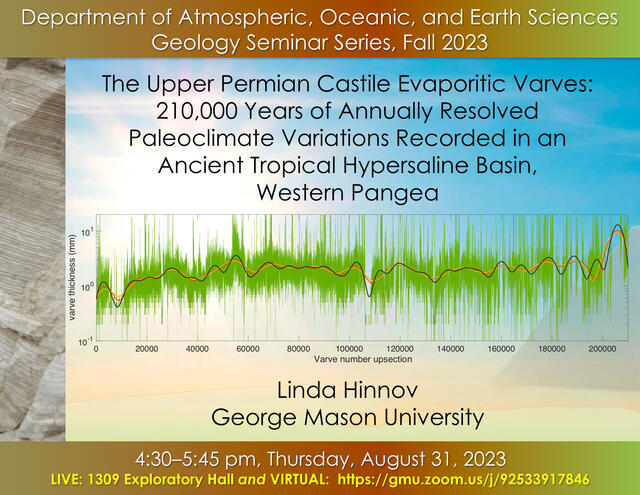
6 Sep (CLIM) Santoni, Wind farms and the Atmosphere
Christian Santoni, Stony Brook U
Weather Research and Forecasting model simulations of wind farms
Wed, 6 Sep, 1:30, via Zoom (for link, email lortizur@gmu.edu)
AOES Host: Luis Ortiz
7 Sep (GEOL) Tian, Invertebrate Paleontology
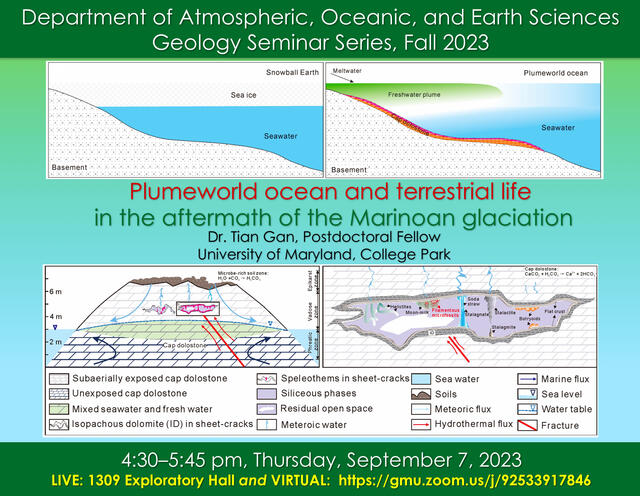
Sep 07 Gan Tian, invertebrate paleontology, University of Maryland, College Park (live)
Thurs., 4:30-5:45 pm, 1309 Exploratory Hall GEOL 392/792;
in-person and Zoom: https://gmu.zoom.us/j/92533917846
13 Sep (CLIM) Goldman, Habitable Worlds
Shawn Domagal-Goldman, NASA Goddard Space Flight Center
Wed, 13 Sep, 1:30, EXPL 3301 and via Zoom (for link, email lortizur@gmu.edu)
The Habitable Worlds Observatory and the Search for Life Beyond the Solar System
Are we alone? This is something humans have philosophized about for ages. NASA has plans to place that question into the domain of the scientific method. We are working with partners across the world on missions that are designed to search for evidence of biological activity on Mars, in the icy worlds in our outer Solar System, and on the myriad exoplanets beyond the Solar System. In this talk we will focus on the mission concept designed to search for life on exoplanets - the Habitable Worlds Observatory (HWO). HWO will be designed to look at reflected-light spectra of Earth-sized planets in the habitable zones of their host stars. This will allow scientists to analyze those spectra and look for signs of life. We will discuss how HWO will achieve this - both scientifically and from an engineering/technology standpoint. And we will showcase some of the work GMU students are doing that is relevant to this future great observatory.
AOES host: Alia Wofford
14 Sep (GEOL) Martin, Structural Geology
Sep 14 Aaron Martin, structural geology, Instituto Potosino, Mexico (live)
Thurs., 4:30-5:45 pm, 1309 Exploratory Hall GEOL 392/792;
in-person and Zoom: https://gmu.zoom.us/j/92533917846
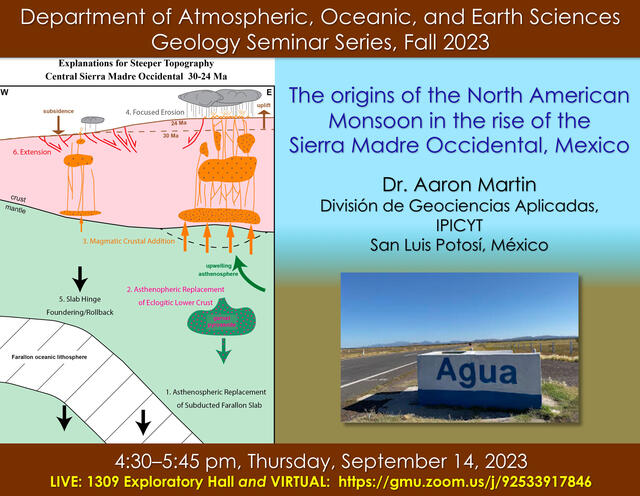
20 Sep (CLIM) Raymond, Compound Storm Threats
Colin Raymond, U California Los Angeles
Compound threats from humid heat and storm systems: Assessment and process understanding
Wed, 20 Sep, 1:30, via Zoom (for link, email lortizur@gmu.edu)
Extreme humid heat and storms are deadly hazards whose severity is expected to increase. When occurring in succession, their interaction can enhance the ultimate impacts, such as power outages removing artificial cooling during subsequent heat events. Recent projects have uncovered a substantial physical-process linkage between these two hazard types. For atmospheric rivers [ARs], we find that moist conditions amplify summertime humid heat, preferentially in the northern third of the US. By contrast, other US regions tend to experience ARs and humid heat separately, representing an important negative correlation of joint risk. For tropical cyclones [TCs], along preferred subtropical coastlines, top-1% humid heat is 3-5x more likely than normal within 24 hours of a TC passage. We employ composites, parcel tracking, and TC dynamical theory to understand the spatiotemporal patterns of this compound threat and the processes driving it. We find, for example, that record-breaking humid heat tends to occur over a much larger area for mid-latitude TCs than for tropical ones, and in areas of ascent but an absence of precipitation.
AOES host: Luis Ortiz
21 Sep (GEOL) Catania, Glaciology
Sep 21 Ginny Catania, glaciology, climate change, University of Texas, Austin (virtual)
Thurs., 4:30-5:45 pm, Zoom: https://gmu.zoom.us/j/92533917846
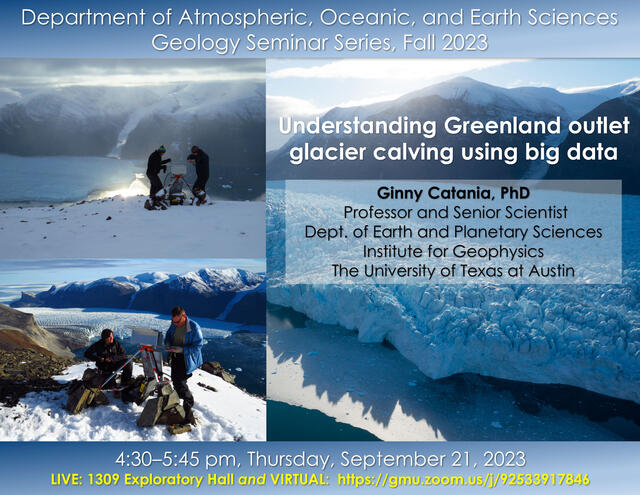
27 Sep (CLIM) Henneman, Air pollution in the US
Lucas R.F. Henneman, George Mason U
Wed, 27 Sep, 1:30, EXPL 3301 and via Zoom (for link, email lortizur@gmu.edu)
AOES host: Luis Ortiz
Coal electricity generating units historically contributed to air pollution and its associated health burden in the United States. The true health burden is unknown, however, because of limited evidence on the health response related specifically to coal pollution. We estimate exposure to fine particulate matter (PM2.5) associated with power plant sulfur dioxide (SO2) emissions from 1,237 US coal power plant units. Exposure is estimated using the HyADS model, which combines information from the HYSPLIT air dispersion and transport model with output from a full-scale chemical transport model to estimate annual coal PM2.5 source impacts from each coal power plant. We link this exposure to the Medicare dataset and find that coal-specific PM2.5 exposure is associated with a greater risk of mortality than PM2.5 from all emissions sources. From 1999-2020, average national coal PM2.5 reduced by about 90%, with consistently higher concentrations in the eastern half of the country. We estimate 460,000 deaths that are attributable to SO2 emissions from US coal power plants. Before 2007, premature deaths averaged over 43,000 per year. After 2007, annual deaths decreased substantially as many facilities installed emissions controls and/or reduced operations. In 2020, we attribute 1,600 mortalities to coal pollution.
28 Sep (GEOL) Gilleaudeau, Sedimentology
Sep 28 Geoffrey Gilleaudeau, sedimentology, George Mason University (live)
Thurs., 4:30-5:45 pm, 1309 Exploratory Hall
GEOL 392/792; in-person and Zoom: https://gmu.zoom.us/j/92533917846

4 Oct (CLIM) Strong, Weather Service Operations
Christopher Strong, National Weather Service
Introduction to National Weather Service Operations
Wed, 4 Oct, 1:30, via Zoom (for link, email lortizur@gmu.edu)
Chris Strong, the Warning Coordination Meteorologist from the National Weather Service's (NWS) Baltimore/Washington Forecast Office will bring us "behind the curtain" to show how the NWS provides life-saving weather warnings and forecasts for the area and the nation. He will also discuss the best way to stay informed in order to stay safe from the multitude of weather threats that can befall our region. Lastly, opportunities to be involved in weather will be discussed, from volunteer efforts to careers as a meteorologist.
AOES host: Cristina Stan
5 Oct (GEOL) Toscano, invertebrate Paleontology
11 Oct (CLIM) Fogel, Energy Transition in Virginia
Jonah Fogel, U Virginia
Energy Transition: A View from Virginia
Wed, 11 Oct, 1:30, via Zoom (for link, email lortizur@gmu.edu)
AOES host: Jim Kinter
12 Oct (GEOL) Marchegiano, Isotope Geochemistry
18 Oct (CLIM) Yue Dong, Remote impacts of the Southern Ocean on tropical pattern effects
Yue Dong, Columbia U
Wed, 18 Oct, 1:30, JC Room E and via Zoom (for link, email lortizur@gmu.edu)
Abstract
Climate feedbacks depend on the spatial pattern of sea-surface temperatures (SSTs) and thus can change over time as SST patterns evolve – the so-called pattern effect. Accounting for the pattern effect reconciles a long-standing issue of incongruent estimates of climate sensitivity between observations and model projections. However, coupled models under historical forcings generally fail to simulate the observed La Niña-like tropical SST pattern over recent decades, and the causes remain an unresolved question.
In this talk, I will focus on the remote impacts on tropical SST patterns from the Southern Ocean. I will present model results where we find various Southern Ocean forcings (including surface heat flux, Antarctic ice-sheet meltwater input, and wind anomalies around Antarctica) can drive significant changes in the tropical Pacific SST pattern. I will argue for an atmospheric pathway involving two-way interactions between the Southern Ocean and the tropical Pacific. These results suggest that the observed tropical SST pattern may have been in part driven by the long-term surface cooling trend in the Southern Ocean.
AOES host: Natalie Burls
25 Oct (CLIM) Drijfhout, Reduced confidence in AMOC projections
Sybren Drijfhout, U Southampton (UK)
Reasons for the reduced confidence in AMOC projections and modelling in the latest IPCC Report (AR6)
Wed, 25 Oct, 1:30, via Zoom (for link, email lortizur@gmu.edu)
AOES host: Barry Klinger
In early 2021, paleo-proxy results suggested that the Atlantic Meridional Overturning Circulation (AMOC) was at its weakest in 1000 years. Climate models predict that anthropogenic climate change will weaken AMOC, but do not support the proxy-based result that this decline began in the early 20th century. The latest IPCC report therefore stated: “given the large discrepancy between modelled and reconstructed AMOC in the twentieth century and the uncertainty over the realism of the 20th century modelled AMOC response, we have low confidence in both.” This statement was further supported by new observations suggesting that models overestimate the role of Labrador-Sea convection in driving AMOC variability. In this seminar I will use examples to illustrate the latest IPCC statement on the AMO; discrepancies between coupled models discussed in IPCC’s AR6 and AR5 and high-resolution models, discuss how model bias impacts AMOC-atmosphere interaction and sea-level rise associated with AMOC decline.
26 Oct (GEOL) Weldeghebriel, Low Temperature Geochemistry
1 Nov (CLIM/GEOL) Plumlee
Geoffree Plumlee, US Geological Service
Wed, 1 Nov, 1:30, EXPL 3301 via Zoom (for link, email lortizur@gmu.edu)
AOES host: Tim DelSole
2 Nov (GEOL) Sharma, Sustainable Energy
Nov 02 Shikha Sharma, sustainable energy, University of West Virginia (virtual)
Thurs., 4:30-5:45 pm, Zoom: https://gmu.zoom.us/j/92533917846
8 Nov (CLIM) Allen, Climate Resilience in Virginia
Michael Allen, Towson University
Wed, 8 Nov, 1:30, TBD, via Zoom (for link, email lortizur@gmu.edu)
The impacts of climate change are all encompassing: economics, national security, ecological disruption, and public health. Much emphasis is placed on building community resilience to future climate impacts, yet the voices of those most heavily affected are often not heard or simply disregarded. Who is resilient? How do ‘we’ make communities resilient? In this presentation, I contextualize the impacts of climate change and consider the ‘unheard voices’:
immigrant farmers, residents of Tangier, the poor, and those who, for whatever reason, may not be able to cope, mitigate, or adapt to changes in our environment. The synthesis also explores aspects of social and environmental [in] justice, equality, and responsibility in the face of climate change.
AOES host: Daniel Vecellio
9 Nov (GEOL) Farhat, Geophysics
15 Nov (CLIM) Molod, Modeling at NASA’s GMAO
Andrea Molod, NASA Goddard Space Flight Center
Wed, 15 Nov, 1:30, Enterprise Hall, 277, via Zoom (for link, email lortizur@gmu.edu)
AOES host: David Straus
16 Nov (GEOL) Whitney, Vertebrate Paleontology
29 Nov (CLIM) Yigit, Gravitational Waves
Erdal Yigit,
Atmospheric gravity wave effects in terrestrial and planetary upper atmospheres
Wed, 29 Nov, 1:30,
Exploratory Hall 3301 and via Zoom (for link, email lortizur@gmu.edu)
AOES host: David Straus
